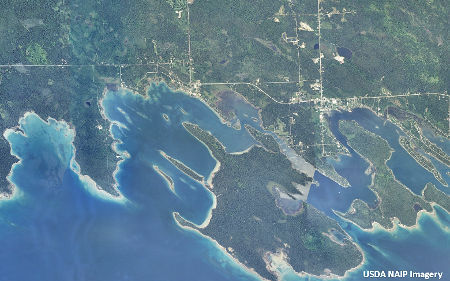Peninsula Effects on Birds in a Coastal Landscape: Are Coves More Species Rich than Lobes?
DOI:
https://doi.org/10.3097/LO.201229Keywords:
Birds, Coastal wetlands, Great lakes, Peninsula effectAbstract
Peninsula effects - decreasing richness with increasing distance along peninsula lobes - have been identified for many taxa on large peninsulas. Peninsula effects are caused by differences in colonization and extinction predicted by island biogeography or by environmental gradients along the peninsula. We compared species-area regressions for cove patches (i.e., mainland) to regressions for lobe patches (i.e., on peninsula tips) for wet meadow birds along a highly interdigitated shoreline (northern Lake Huron, USA). We conducted analysis both with and without accounting for variation in habitat and landscape characteristics (i.e., environmental gradients) of wet meadows. Species-area regressions for coves did not differ from lobes, nor did these results differ when we accounted for gradients. Similarly, few species were more abundant in coves. Peninsula effects may have been lacking because lobe patches were located ≈ 800 m on average from the mainland, and birds are highly mobile and can easily sample patches over these distances. One important caveat was that wet meadow patches > 5 ha were located in coves, so coves would still be important considerations in conservation plans because of the contribution of large patches to reproductive success, dispersal and population dynamics.
References
Brown, M., & Dinsmore, J. J. (1986). Implications of marsh size and isolation for marsh bird management. Journal of Wildlife Management, 50(3), 392-397. doi:10.2307/3801093
Craig, R. J., & Beal, K. G. (1992). The influence of habitat variables on marsh bird communities of the connecticut river estuary. Wilson Bulletin, 104(2), 295-311.
Forman, R. T. T. (1995). Land Mosaics: The Ecology of Landscapes and Regions,
Forman, R. T. T., & Godron, M. (1986). Landscape Ecology,
Gibbs, J. P., & Melvin, S. M. (1993). Call-response surveys for monitoring breeding waterbirds. Journal of Wildlife Management, 57(1), 27-34. doi:10.2307/3808996
Gutzwiller, K. J., & Anderson, S. H. (1992). Interception of moving organisms: Influences of patch shape, size, and orientation on community structure. Landscape Ecology, 6(4), 293-303. doi:10.1007/BF00129707
Helzer, C. J., & Jelinski, D. E. (1999). The relative importance of patch area and perimeter-area ratio to grassland breeding birds. Ecological Applications, 9(4), 1448-1458. doi:10.1890/1051-0761(1999)009[1448:TRIOPA]2.0.CO;2
Herkert, J. R. (1994). The effects of habitat fragmentation on midwestern grassland bird communities. Ecological Applications, 4(3), 461-471. doi:10.2307/1941950
Jenkins, D. G., & Rinne, D. (2008). Red herring or low illumination? the peninsula effect revisited. Journal of Biogeography, 35(11), 2128-2137. doi:10.1111/j.1365-2699.2008.01943.x
MacArthur, R. H., & Wilson, E. O. (2015). The theory of island biogeography (MPB-1). The theory of island biogeography (MPB-1) (pp. 1-203)
Milne, B. T., & Forman, R. T. T. (1986). Peninsulas in maine: Woody plant diversity, distance, and environmental patterns. Ecology, 67(4), 967-974. doi:10.2307/1939819
Morrison, M. L., Marcot, B. G., & Mannan, R. W. (1992). Wildlife-Habitat Relationships: Concepts and Applications,
Naugle, D. E., Higgins, K. F., Nusser, S. M., & Johnson, W. C. (1999). Scale-dependent habitat use in three species of prairie wetland birds. Landscape Ecology, 14(3), 267-276. doi:10.1023/A:1008088429081
Orians, G. H. (1980). Some adaptations of marsh-nesting blackbirds. Monographs in Population Biology, (14), 1-295.
Ott, L. (2005). An Introduction to Statistical Methods and Data Analysis,
Poole, A. (2005).
Rahbek, G. (1997). The relationship among area, elevation, and regional species richness in neotropical birds. American Naturalist, 149(5), 875-902. doi:10.1086/286028
Ribic, C. A., Koford, R. R., Herkert, J. R., Johnson, D. H., Niemuth, N. D., Naugle, D. E., . . . Renfrew, R. B. (2009). Area sensitivity in north american grassland birds: Patterns and processes. Auk, 126(2), 233-244. doi:10.1525/auk.2009.1409
Riffell, S. K., Gutzwiller, K. J., & Anderson, S. H. (1996). Does repeated human intrusion cause cumulative declines in avian richness and abundance? Ecological Applications, 6(2), 492-505. doi:10.2307/2269386
Riffell, S. K., Keas, B. E., & Burton, T. M. (2001). Area and habitat relationships of birds in great lakes coastal wet meadows. Wetlands, 21(4), 492-507. doi:10.1672/0277-5212(2001)021[0492:AAHROB]2.0.CO;2
Riffell, S. K., Keas, B. E., & Burton, T. M. (2003). Birds in north american great lakes coastal wet meadows: Is landscape context important? Landscape Ecology, 18(2), 95-111. doi:10.1023/A:1024411218155
Ross Kiester, A. (1971). Species density of north american amphibians and reptiles. Systematic Zoology, 20(2), 127-137. doi:10.2307/2412053
Rotenberry, J. T., & Wiens, J. A. (1980). Habitat structure, patchiness, and avian communities in north american steppe vegetation: A multivariate analysis. Ecology, 61, 1228-1250.
Schwartz, M. W. (1999). Choosing the appropriate scale of reserves for conservation. Annual Review of Ecology and Systematics, 30, 83-108. doi:10.1146/annurev.ecolsys.30.1.83
Silva, J. M. C. (1996). Distribution of amazonian and atlantic birds in gallery forests of the cerrado region, south america. Ornitologia Neotropical, 7(1), 1-18.
Simpson, G. G. (1964). Species density of north american recent mammals. Systematic Zoology, 13(1-4), 57-73. doi:10.2307/sysbio/13.1-4.57
Taylor, R. J., & Regal, P. J. (1978). The peninsular effect on species diversity and the biogeography of baja california. American Naturalist, 112(985), 583-593.
Terres, J. K. (1980). The Audubon Society Encyclopedia of North American Birds,
Tubelis, D. P., Lindenmayer, D. B., & Cowling, A. (2007). The peninsula effect on bird species in native eucalypt forests in a wood production landscape in australia. Journal of Zoology, 271(1), 11-18. doi:10.1111/j.1469-7998.2006.00174.x
Vickery, P. D., Tubaro, P. L., Da Silva, J. M. C., Peterjohn, B. G., Herkert, J. R., & Cavalcanti, R. B. (1999). Conservation of grassland birds in the western hemisphere
Waide, R. B., & Narins, P. M. (1988). Tropical forest bird counts and the effect of sound attenuation. Auk, 105, 296-302.
Westmoreland, D., & Best, L. B. (1985). The effect of disturbance on mourning dove nesting success. Auk, 102(4), 774-780.
Wiggins, D. A. (1999). The peninsula effect on species diversity: A reassessment of the avifauna of baja california. Ecography, 22(5), 542-547. doi:10.1111/j.1600-0587.1999.tb01284.x
Zarr, J. H. (1984). Biostatistical Analysis,

Downloads
Published
How to Cite
Issue
Section
License
Copyright (c) 2019 Sam Riffell, Brian Keas, Thomas Burton

This work is licensed under a Creative Commons Attribution 4.0 International License.










